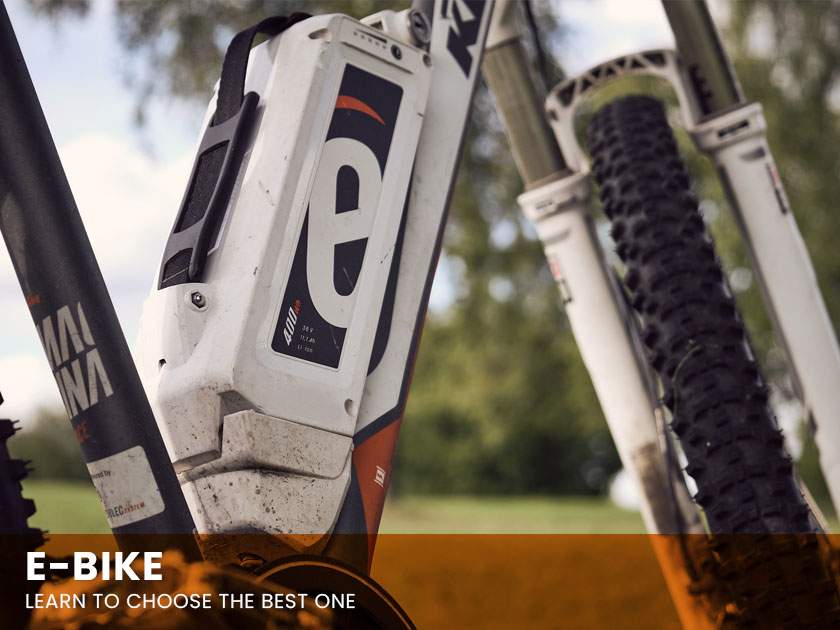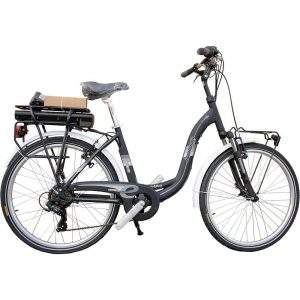FREE SHIPPING STARTING FROM 89€
Fast delivery with express courier
30 DAYS MONEY BACK GUARANTEE
How e-bike works? How to choose the best one?

E-bikes are becoming more and more popular among cyclists. On the surface, it looks like a traditional bicycle, it's a quiet, unpretentious bike, but it hides a technological and efficient engine.
But how does an e-bike work? Some people think that riding this advanced bike requires no effort and that the engine does everything by itself.
Others still think that these are heavy and slow bikes, not suitable for those who aim to improve their performance.
What a mess! Let's try to make it a little bit clearer and understand how e-bikes work and what aspects we must evaluate in when choosing one.
E-bike or electric bike? Let's see the difference!
Before explaining how an e-bike works, it's important to clarify the difference between e-bike and electric bike and understand which vehicle we're talking about. These are bicycles with a motor that supports pedaling and which are also called pedal assisted bicycles. E-bikes should not be confused with real electric bikes, which instead have a motor that is activated regardless of the pedaling.
Electric bicycles are motor vehicles to all intents and purposes, which require regular homologation, with all the charges that this entails, and perhaps that's why they're not so common. We often talk about electric bikes also when we want to indicate e-bikes, which do not require any license and are treated by the Traffic Laws as very common bicycles.
Riding an e-bike, therefore, does not need any registration, nor a license number, nor even insurance. They can circulate without restrictions on cycle paths and also on the road, as you would do with a traditional bike.
How an e-bike works
The e-bikes or pedal-assisted bicycles are equipped with a small and light motor, located inside the rear or front hub, on the frame in a central position or above the rear wheel.
If the first engines were heavy and not very performing, today the situation has definitely changed. Today's engines are not very bulky and their strategic position doesn't disturb the pedaling at all. Pedal-assisted bikes are slightly heavier than traditional bikes, but the thrust of the motor allows the cyclist not to perceive the difference in weight.
The e-bike engines are equipped with a torque sensor, which offers a thrust proportional to the cyclist's effort on the pedals. As the effort and pedaling frequency increase, the assistance of the electric motor will also increase.
The e-bikes are equipped with 250 watt and 36 volt motors and, in order to comply with the indications of the Traffic Laws, they can assist pedaling up to a maximum speed of 25 km/h. Once this speed has been exceeded, the motor is deactivated and the bike's pace depends only on the cyclist's muscles and the inclination of the road.
To ride an electric bike, all you have to do is get in the saddle and start pedaling. Engine assistance greatly reduces effort and undoubtedly makes it easier to tackle the most difficult climbs or routes.
The beauty of e-bikes is that they are available in a wide variety of models. In addition to city bikes, you can also ride a mountain bike with an electric motor, to have unlimited fun even on dirt roads.
How to charge an e-bike?
 Batteries are the most important component of the engine and it is precisely on the improvement of their performance that the efforts of the manufacturers have been concentrated. The result of so much work are lightweight batteries that guarantee a range of almost 100 km and that can be recharged in 4 or 5 hours.
Batteries are the most important component of the engine and it is precisely on the improvement of their performance that the efforts of the manufacturers have been concentrated. The result of so much work are lightweight batteries that guarantee a range of almost 100 km and that can be recharged in 4 or 5 hours.
The battery of the Lombardo e-Sestriere Sport 5.0 bike that you can see in the picture, can be recharged in just 3.5 hours! Not bad, right?
Most batteries can be disconnected from the frame and the e-bike can be recharged using a normal electrical outlet. The bike also comes with a battery charger, very similar to the one used for our smartphones.
If we think about it, in fact, the technology used is the same, because they are lithium or Li-Ion batteries. These batteries can boast a very long life cycle, which in some cases can support over 1000 charging cycles.
The battery life is linked to several factors, such as the weight of the cyclist, the pace of training and the number of stops. Usually, with a full charge you can cover from 40 to 70 km, but in Eco mode you can reach up to 100 km.
Which e-bike to choose?
There are several factors to consider when choosing an e-bike, most of which concern the cyclist and his or her habits. The most important question to answer is what kind of cyclist are you? There are so many solutions available that can be tailored to a wide range of needs.
 If you think of using the electric bike only for city travel and small tasks, you could opt for a city bike. The Lombardo e-Elba Sport model, for example, combines the comfort of a city bike with the grit of a sports ebike.
If you think of using the electric bike only for city travel and small tasks, you could opt for a city bike. The Lombardo e-Elba Sport model, for example, combines the comfort of a city bike with the grit of a sports ebike.
If you usually carry your bike on the train or on public transport, you'll find a folding ebike more comfortable, but don't underestimate the weight.
Cyclists with a sporting temperament will have no doubt and will choose an electric mountain bike, so as to have that extra support uphill and during the most challenging paths.
Choosing an ebike is not just a matter of style and you'll have to consider other factors as well. Here are the most important aspects of the choice:
- The location of the battery, to be chosen according to the use you will have to make of the bike and the space needed for a possible rack for bike;
- Recharging times and the autonomy of the e-bike, to be evaluated taking into account the distance you intend to cover during your trips and the frequency of use;
- The weight of the e-bike, especially if you have to make it go up a flight of stairs or on public transport.
The choice is always very personal and depends on the way you live your bike. There are many cyclists who let themselves be guided by instinct, but if you need a technical opinion, contact me and tell me about your needs. Sometimes a simple chat of a few minutes is enough to eliminate the perplexities and find the best solution for you.